Apple iPhone 4S: Thoroughly Reviewed
by Anand Lal Shimpi & Brian Klug on October 31, 2011 7:45 PM EST- Posted in
- Smartphones
- Apple
- Mobile
- iPhone
- iPhone 4S
Display
Though many expected Apple to redesign everything around a 4“ display, the display on the 4S superficially identical. The 4S includes the same size and resolution display as the 4, namely a 3.54” IPS panel with 960x640 resolution. We’ve been over this a few times already in the context of the iPhone 4 and the CDMA iPhone 4, but it bears going over again.
In retrospect, moving up to 4“ would’ve gone against Apple’s logical approach to maintaining a DPI-agnostic iOS, and it makes sense to spread the cost of changing display resolution across two generations, which is what we see now. While Android is gradually catching up in the DPI department, OEMs on that side of the fence are engaged in a seemingly endless battle over display size. You have to get into Apple’s head and understand that from their point of view, 3.5” has always been the perfect size - there’s a reason it hasn’t changed at all.
I’ve been through a few 4s myself, and alongside the CDMA iPhone 4, have seen the white point of the retina display gradually shift over time. While I don’t have that original device anymore, even now the 4S seems to have shifted slightly compared to a very recently manufactured 4 I had on hand, and appears to have a different color temperature. We’ve been measuring brightness and white point on smartphone displays at a variety of different brightness settings, and the 4S isn’t spared the treatment. I also tossed in my 4 for comparison purposes. The data really speaks for itself.

The first chart shows white point at a number of brightness values set in settings. You can see the iPhone 4 and 4S differ and straddle opposite sides of 6500K. I would bet that Apple has some +/- tolerance value for these displays from 6500K, and the result is what you see here. Thankfully the lines are pretty straight (so it doesn’t change as you vary brightness), but this variance is why you see people noting that one display looks warmer or cooler than the other. I noted this behavior with the CDMA iPhone 4, and suspect that many people still carrying around launch GSM/UMTS iPhone 4 devices will perceive the difference more than those who have had their devices swapped.
The next two charts show display brightness at various settings for solid black and white on the display.
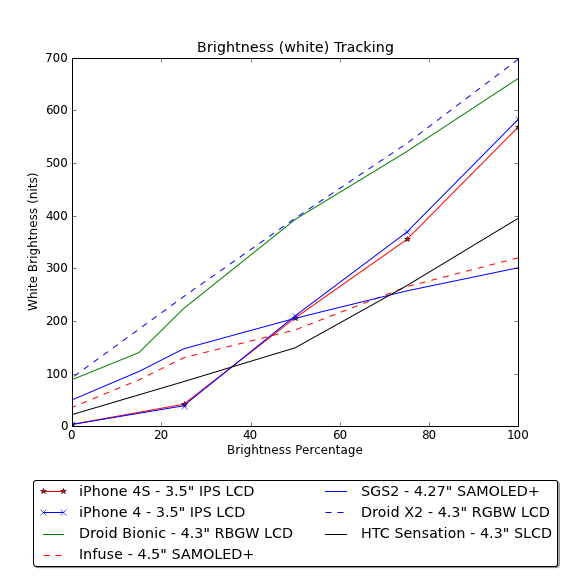
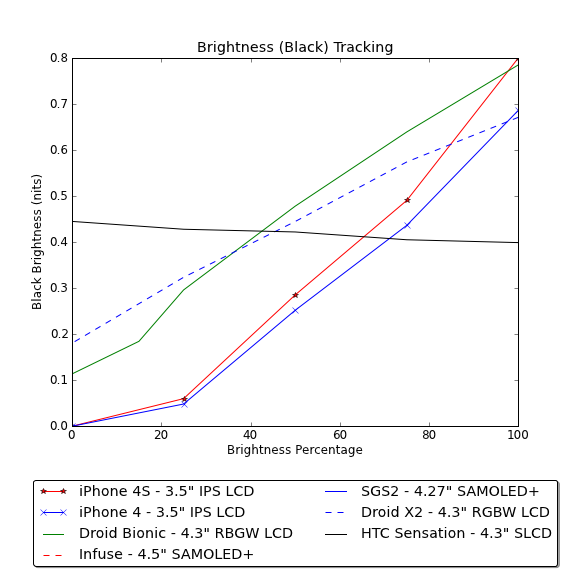
The 4S and 4 displays follow roughly the same curve, however there is a definite shift in contrast resulting from higher black levels on the 4S display. I’ve seen a few anecdotal accounts of the 4S display being less contrasty, and again this is the kind of shift that unfortunately happens over time with displays. I’ve updated our iPhone 4 result on the graph with the latest of a few I’ve been through.
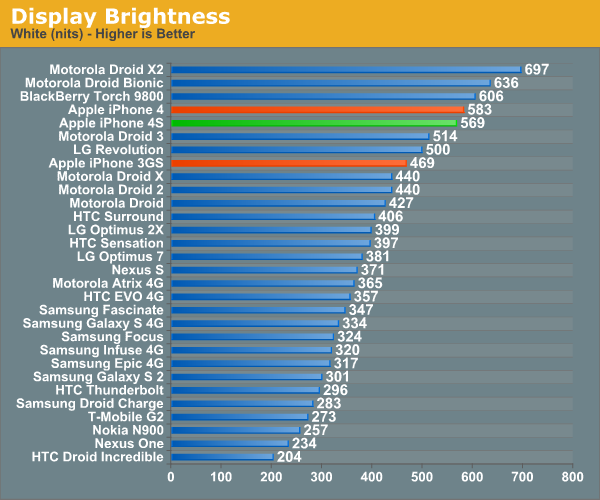
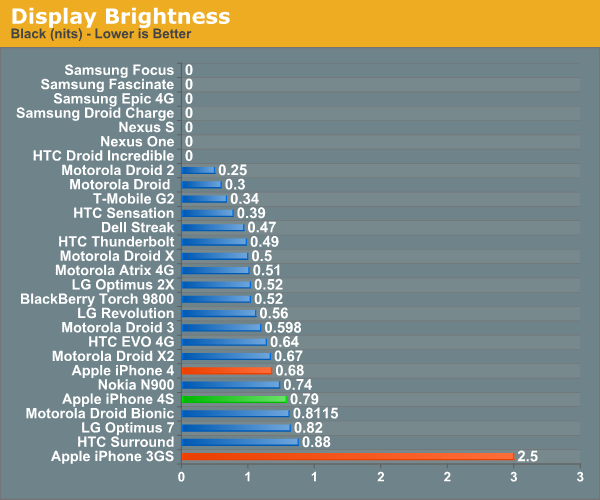
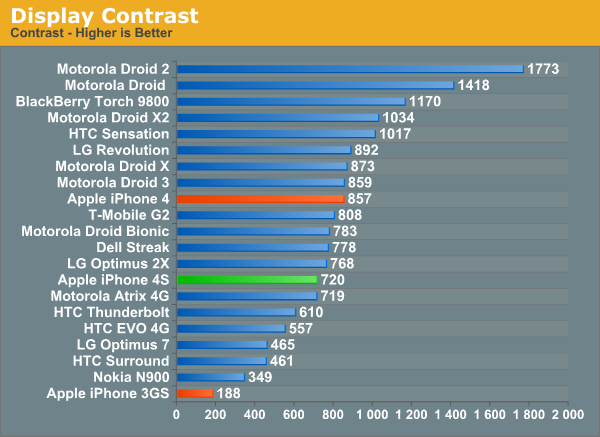
Unfortunately the 4S falls short of the quoted 800:1 contrast ratio, whereas the 4 previously well exceeded it (the earliest 4 we saw had a contrast value of 951). Rumor has it that Apple has approved more panel vendors to make the retina display, I have no doubt that we’re seeing these changes in performance as a result of multiple sourcing.










199 Comments
View All Comments
metafor - Tuesday, November 1, 2011 - link
When you say power efficiency, don't you mean perf/W?I agree that perf/W varies depending on the workload, exactly as you explained in the article. However, the perf/W is what makes the difference in terms of total energy used.
It has nothing to do with race-to-sleep.
That is to say, if CPU B takes longer to go to sleep but it had been better perf/W, it would take less power. In fact, I think this was what you demonstrated with your second example :)
The total energy consumption is directly related to how power-efficient a CPU is. Whether it's a slow processor that runs for a long time or a fast processor that runs for a short amount of time; whichever one can process more instructions per second vs joules per second wins.
Or, when you take seconds out of the equations, whichever can process more instructions/joule wins.
Now, I assume you got this idea from one of Intel's people. The thing their marketing team usually forgets to mention is that when they say race-to-sleep is more power efficient, they're not talking about the processor, they're talking about the *system*.
Take the example of a high-performance server. The DRAM array and storage can easily make up 40-50% of the total system power consumption.
Let's then say we had two hypothetical CPU's with different efficiencies. CPU A being faster but less power efficient and CPU B being slower but more power efficient.
The total power draw of DRAM and the rest of the system remains the same. And on top of that, the DRAM and storage can be shut down once the CPU is done with its processing job but must remain active (DRAM refreshed, storage controllers powered) while the CPU is active.
In this scenario, even if CPU A draws more power processing the job compared to CPU B, the system with CPU B has to keep the DRAM and storage systems powered for longer. Thus, under the right circumstances, the system containing CPU A actually uses less overall power because it keeps those power-hungry subsystems active for a shorter amount of time.
However, how well this scenario translates into a smartphone system, I can't say. I suspect not as well.
Anand Lal Shimpi - Tuesday, November 1, 2011 - link
I believe we're talking about the same thing here :)The basic premise is that you're able to guarantee similar battery life, even if you double core count and move to a power hungry OoO architecture without a die shrink. If your performance gains allow your CPU/SoC to remain in an ultra low power idle state for longer during those workloads, the theoretically more power hungry architecture can come out equal or ahead in some cases.
You are also right about platform power consumption as a whole coming into play. Although with the shift from LPDDR1 to LPDDR2, an increase in effective bandwidth and a number of other changes it's difficult to deal with them independently.
Take care,
Anand
metafor - Tuesday, November 1, 2011 - link
"If your performance gains allow your CPU/SoC to remain in an ultra low power idle state for longer during those workloads, the theoretically more power hungry architecture can come out equal or ahead in some cases."Not exactly :) The OoOE architecture has to perform more tasks per joule. That is, it has to have better perf/W. If it had worse perf/W, it doesn't matter how much longer it remains idle compared to the slower processor. It will still use more net energy.
It's total platform power that may see savings, despite a less power-efficient and more power-hungry CPU. That's why I suspect that this "race to sleep" situation won't translate to the smartphone system.
The entire crux relies on the fact that although the CPU itself uses more power per task, it saves power by allowing the rest of the system to go to sleep faster.
But smartphone subsystems aren't that power hungry, and CPU power consumption generally increases with the *square* of performance. (Generally, this wasn't the case of A8 -> A9 but you can bet it's the case to A9 -> A15).
If the increase in CPU power per task is greater than the savings of having the rest of the system active for shorter amounts of time, it will still be a net loss in power efficiency.
Put it another way. A9 may be a general power gain over A8, but don't expect A15 to be so compared to A9, no matter how fast it finishes a task :)
doobydoo - Tuesday, November 1, 2011 - link
You are both correct, and you are also both wrong.Metafor is correct because any chip, given a set number of tasks to do over a fixed number of seconds, regardless of how much faster it can perform, will consume more energy than an equally power efficient but slower chip. In other words, being able to go to sleep quicker never means a chip becomes more power efficient than it was before. It actually becomes less.
This is easily logically provable by splitting the energy into two sections. If 2 chips are both equally power efficient (as in they can both perform the same number of 'tasks' per W), if one is twice as fast, it will consume twice the energy during that time, but complete in half the time, so that element will ALWAYS be equal in both chips. However, the chip which finished sooner will then have to be idle for LONGER because it finished quicker, so the idle expense of energy will always be higher for the faster chip. This assumes, as I said, that the idle power draw of both chips being equal.
Anand is correct, because if you DO have a more power efficient chip with a higher maximum wattage consumption, race to sleep is the OFTEN (assuming reasonable idle times) the reason it can actually use less power. Consider 2 chips, one which consumes 1.3 W per second (max) and can carry out '2' tasks per second. A second chip consumes 1 W per second (max), and can carry out '1' task per second (so is less power efficient). Now consider a world without race-to-sleep. To carry out '10' tasks over a 10 second period, Chip one would take 5 seconds, but would remain on full power for the full 10 seconds, thereby using 13W. Chip two would take 10 seconds, and would use a total of 10W over that period. Thus, the more power efficient chip actually proved less power efficient.
Now if we factor in race-to-sleep, the first chip can use 1.3 for the first 5 seconds, then go down to 0.05 for the last 5. Consuming 6.75W. The second chip would still consume the same 10W.
Conclusion:
If the chip is not more power effficient, it can never consume less energy, with or without race-to-sleep. If the chip IS more power efficient, but doesn't have the sleep facility, it may not use less energy in all scenarios.
In other words, for a higher powered chip to reduce energy in ALL situations, it needs to a) be more power efficient fundamentally, and b) it needs to be able to sleep (race-to-sleep).
djboxbaba - Monday, October 31, 2011 - link
Well done on the review Brian and Anand, excellent job as always. I was resisting the urge to tweet you about the eta of the review, and of course I end up doing it the same day as your release the review :).Mitch89 - Monday, October 31, 2011 - link
"This same confidence continues with the 4S, which is in practice completely usable without a case, unlike the GSM/UMTS iPhone 4. "Everytime I read something like this, I can't help but compare it to my experience with iPhone 4 reception, which was never a problem. I'm on a very good network here in Australia (Telstra), and never did I have any issues with reception when using the phone naked. Calls in lifts? No problem. Way outside the suburbs and cities? Signal all the way.
I never found the iPhone 4 to be any worse than other phones when I used it on a crappy network either.
Worth noting, battery life is noticeably better on a strong network too...
wonderfield - Tuesday, November 1, 2011 - link
Same here. It's certainly possible to "death grip" the GSM iPhone 4 to the point where it's rendered unusable, but this certainly isn't the typical use case. For Brian to make the (sideways) claim that the 4 is unusable without a case is fairly disingenuous. Certainly handedness has an impact here, but considering 70-90% of the world is right-handed, it's safe to assume that 70-90% of the world's population will have few to no issues with the iPhone 4, given it's being used in an area with ample wireless coverage.doobydoo - Tuesday, November 1, 2011 - link
I agree with both of these. I am in a major capital city which may make a difference, but no amount or technique of gripping my iPhone 4 ever caused dropped calls or stopped it working.Very much an over-stated issue in the press, I think
ados_cz - Tuesday, November 1, 2011 - link
It was not over-stated at all and the argument that most people are right handed does not hold a ground. I live in a small town in Scotland and my usual signal strength is like 2-3 bars. If browsing on net on 3G without case and holding the iPhone 4 naturaly with left hand (using the right hand for touch commands ) I loose signal completely.doobydoo - Tuesday, November 1, 2011 - link
Well the majority of people don't lose signal.I have hundreds of friends who have iPhone 4's who've never had any issue with signal loss at all.
The point is you DON'T have to be 'right handed' for them to work, I have left handed friends who also have no issues.
You're the exception, rather than the rule - which is why the issue was overstated.
For what it's worth, I don't believe you anyway.